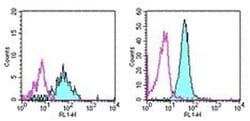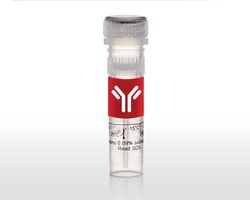CD13 Monoclonal Antibody (WM-15 (WM15)), eBioscience™, Invitrogen™
Manufacturer: Invitrogen
Select a Size
| Pack Size | SKU | Availability | Price |
|---|---|---|---|
| Each of 1 | 14-013-837-Each-of-1 | In Stock | ₹ 1,22,108.00 |
14-013-837 - Each of 1
In Stock
Quantity
1
Base Price: ₹ 1,22,108.00
GST (18%): ₹ 21,979.44
Total Price: ₹ 1,44,087.44
Antigen
CD13
Classification
Monoclonal
Concentration
0.5 mg/mL
Formulation
PBS with 0.09% sodium azide; pH 7.2
Gene Accession No.
P15144
Gene Symbols
ANPEP
Purification Method
Affinity chromatography
Regulatory Status
RUO
Gene ID (Entrez)
290
Content And Storage
4° C
Form
Liquid
Applications
Flow Cytometry, Immunohistochemistry
Clone
WM-15 (WM15)
Conjugate
Unconjugated
Gene
ANPEP
Gene Alias
alanyl (membrane) aminopeptidase; alanyl (membrane) aminopeptidase (aminopeptidase N, aminopeptidase M, microsomal aminopeptidase, CD13, p150); alanyl aminopeptidase; alanyl aminopeptidase, membrane; aminopeptidase; aminopeptidase Ey; Aminopeptidase M; aminopeptidase N; aminopeptidase N.; aminopeptidase N/CD13; Anpep; APDE; Apm; AP-M; APN; AP-N; bAPN; cAPN; Cd13; cluster of differentiation antigen 13 (CD13); fAPN; gp130; gp150; h AP-N; hAPN; kidney aminopeptidase M; kidney Zn peptidase; KZP; Lap1; Lap-1; leucine arylaminopeptidase 1; LOW QUALITY PROTEIN: aminopeptidase N; membrane alanine aminiopeptidase; membrane alanine aminopeptidase; membrane alanyl aminopeptidase; membrane protein p161; Microsomal aminopeptidase; myeloid plasma membrane glycoprotein CD13; p150; pAPN; PEPN; porcine aminopeptidase N; rAPN; rbAPN; Unknown (protein for MGC:126949)
Host Species
Mouse
Quantity
2 mg
Primary or Secondary
Primary
Target Species
Human
Product Type
Antibody
Isotype
IgG1 κ
Description
- Description: The WM-15 monoclonal antibody reacts with human CD13, also known as aminopeptidase N
- CD13 is a transmembrane ectoenzyme occurring on monocytes and granulocytes but not lymphocytes in blood
- It is also reportedly on a wide variety of cells and in a wide variety of tissues, including endothelial cells, epithelial cells, fibroblasts, kidney proximal tubules, intestine, and placenta
- CD13 is reported to have many different functions including degradation of enkephalins and endorphins, terminal degradation of peptides, amino acid scavenging, antigen processing, and adhesion and migration of cells
- Applications Reported: The WM-15 (WM15) antibody) has been reported for use in flow cytometric analysis, and microscopy
- Applications Tested: The WM-15 (WM15) antibody has been tested by flow cytometric analysis of lysed whole blood
- This can be used at less than or equal to 1 μg per test
- A test is defined as the amount (μg) of antibody that will stain a cell sample in a final volume of 100 μL
- Cell number should be determined empirically but can range from 10^5 to 10^8 cells/test
- It is recommended that the antibody be carefully titrated for optimal performance in the assay of interest
- Purity: Greater than 90%, as determined by SDS-PAGE
- Aggregation: Less than 10%, as determined by HPLC
- Filtration: 0.2 μm post-manufacturing filtered
- CD13 (ANPEP) is a 150-170 kDa type II transmembrane zinc-binding ectopeptidase expressed on various cell types
- CD13 is a metalloprotease that preferentially catalyzes removal of neutral amino acids from small peptides, thus activating or inactivating bioactive peptides
- CD13 also has a role in extracellular matrix degradation, antigen processing and signal transduction, is important in inflammatory responses, regulates intercellular contact, cell motility and vascularization
- CD13 is expressed by granulocytes, monocytes, myeloid leukemia cells, and is involved in protection of leukemic cells against apoptosis and its expression associated with poor prognosis of carcinomas
- CD13 functions as an aminopeptidase enzyme and is also alpha receptor for coronavirus.


